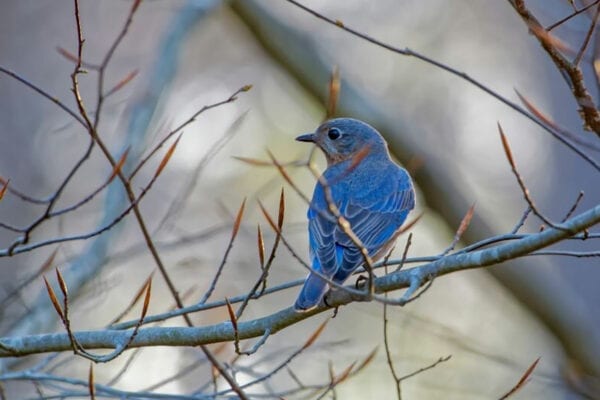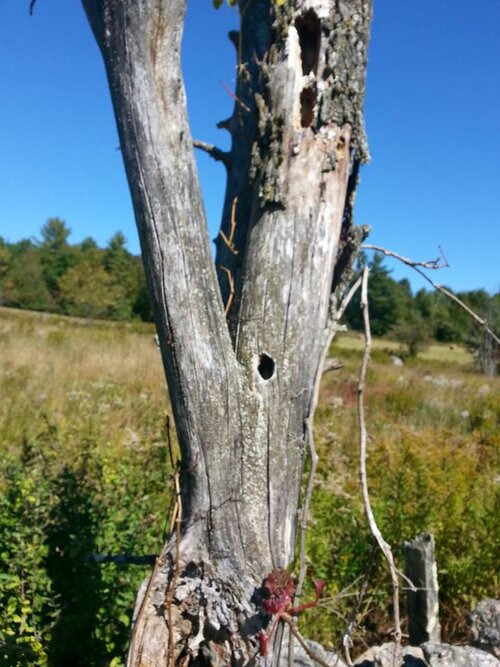
photo by Scott Johnson
I’m delighted to report that we might finally have Eastern Bluebirds nesting in our home habitat. We’ve lived here in Poland Spring for over a decade, and have never put up a nest box. However, I am kind of a fanatic about retaining and promoting dead and dying trees on our landscape because “dead and dying trees are key to life”. I think my persistence is finally paying off!
This afternoon we planted several native shrubs for wildlife along our wooded edge and then sat on the deck to admire our work. It was then that we spotted a beautiful male Eastern Bluebird perched on a tree branch on the lower edge of our woods. I excitedly pointed the bird out to our 12-year-old daughter, who had first sighted a bluebird in our yard a few days ago. I watched its movements with my binoculars and saw it land just below a hole on a short birch snag (dead standing tree). I was beside myself with excitement. After scanning the area for danger, the bird ducked in and out of the cavity, and then flew away to hunt for more food.
Bluebirds are “secondary cavity nesters,” meaning they rely on holes that have been previously excavated by woodpeckers or another “primary excavator.” It also means that they readily use artificial nesting structures (nest boxes).
Bluebirds flourished during the colonial settlement period when forests were cleared for agriculture. Farmers lined their fields with wooden fence posts, which decayed and provided ample nesting sites. Several factors led to a drastic population decline in the twentieth century including nest-site competition from introduced birds (European Starling and House Sparrow), and native species (Tree Swallow), widespread replacement of wooden fence posts with metal posts, and pesticide use. Since then, bluebirds have been on the rebound thanks to more increased beaver activity in remote areas, providing more standing dead trees, and due to the many nest boxes that have been installed across their breeding range by bluebird enthusiasts.

I came across this nice “cavity tree” on a client’s property on the edge of a hayfield in Livermore. Based on its location, the diameter of the cavity, and the south-facing aspect – this is the perfect natural nesting habitat for our beloved bluebirds, Photo by Deb Perkins
Bluebird boxes are great (as long as they are properly installed and maintained), but nothing beats a natural nesting cavity! Before you cut down that old “rotten” tree, please consider retaining it — as safety permits — as natural habitat for bluebirds, and all the other species that rely on these structures. Insects will eat (and nest in) the decaying wood, the woodpeckers will excavate cavities for nesting and feeding, and then bluebirds can raise scores of young inside your dead or dying tree.
Keep in mind, the best bluebird habitat will also have low exposed perches (wires, branches, and fence posts) that allow birds to scan the ground for their prey (grasshoppers, crickets, caterpillars, and more). To ensure that the birds have plenty to eat, and to feed their growing young, the best habitat will also be composed of mostly native plants (70% or more) – the basis for healthy and diverse insect populations that in turn, support healthy bird populations.
I’m very hopeful that the male bluebird who delighted my senses this afternoon was feeding chicks in our birch snag. I’ll be watching closely tomorrow from my deck, cup of tea in hand.
In the meantime, please share the value of dead and dying trees with your communities. Our human compulsion to “clean up the woods” and “cut down that dead/dying tree” robs our landscapes of important nutrients, structures, and nesting opportunities.
This is how we conserve wildlife: one dead tree at a time, one shrub at a time, one wildflower at a time.
by Deb Perkins, owner of First Light Wildlife Habitats
To learn more about First Light Wildlife Habitats or to ask about getting a personal property consultation visit www.firstlighthabitats.com.











I have a nest in my box for Bluebirds they laid four eggs shortly after I found the headless body of Bluebird in my yard about six feet from the nesting area. The eggs have been unattended for three months, what should I do with eggs and the nest?
At this point, you can clean out the box, tossing the contents into the woods or some place where you’re comfortable, knowing that raccoons or other wildlife may come around to eat them.
Hopefully the bluebirds will try again, with success, next year!
Allison and Jeff Wells
I have bluebirds which laid only 2 eggs about a week ago. They come back to the nest every.day Is this normal?
My daughter had a nest in her mail box where the paper goes. The cow bird actually laid eggs in the nest too. The bluebirds raised them all. Nature is amazing.